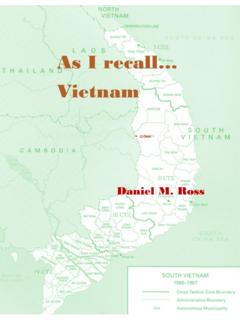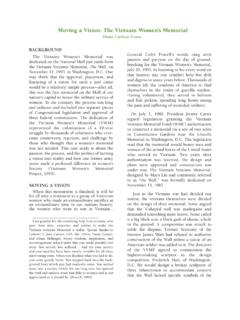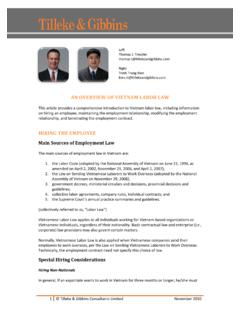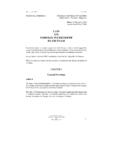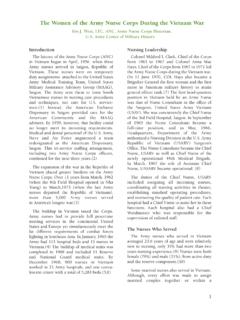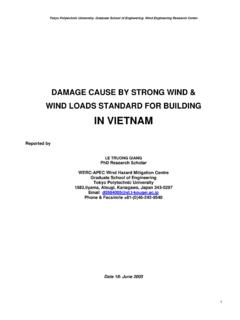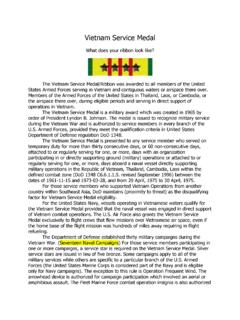Transcription of Khe Sanh - Vietnam Memoirs
1 khe sanh . Army Air Defenders Defend Besieged Marine Combat Base Story and Photos by Bruce Geiger khe sanh Combat Base, site of the most famous siege and one of the most controversial battles of the American Vietnam War, sits silently on a barren plateau surrounded by vegeta- tion-covered hills often obscured by mist and fog. It is hard to imagine as you stand in this peaceful, verdant land that in this very place in early 1968 took place the bloodiest battle of the Vietnam War.. But little things help you picture what the history books say happen here. The outline of the airfield remains distinct (to this day nothing will grow on it). In places, the ground is literally carpeted with bullets and rusting shell casings. Vietnam , A Lonely Planet Travel Survival Kit . "There is no feeling in the world as good as being airborne out of khe sanh ", wrote Michael Herr in Dis- patches, one of the Vietnam War's most celebrated books, but that was thirty years ago.
2 Today, travel guides beckon tourists to visit khe sanh Combat Base. It's one of several abandoned combat bases, including Con Thien, Camp Carroll and the Rockpile, that you can visit as part of a day trip, provided you have a good four- wheel drive. Buy a travel permit for ten dollars at the Quang Tri Province Tourist Office in Dong Ha and follow National Highway 9, which parallels the old DMZ, west out of Dong Ha toward Laos. Turn northwest at the triangular intersection just before you reach khe sanh Town. The base is on the right-hand side of the road, two and a half kilometers from the intersection. Thirty years ago, I led a column of Dusters and Quad 50s out of khe sanh at the end of a 75-day siege. Most Vietnam vets who were fortunate enough not to have left the combat base in body bags probably figure their one trip to khe sanh was enough to last a lifetime. But I'd love to drive a Jeep Cherokee up Route 9, stand in the middle of the abandoned combat base and remember that "I was a soldier once and young.
3 My route to Khe Sahn was a circuitous one that started in a Nike Hercules fire control center and led to a Duster turret. My military career began during the summer of 1966 when I received my commission at the Army ROTC training facility in Indiantown Gap, Pennsylvania, after I graduated from Rutgers University. I em- barked on active duty in October 1966 as a second lieutenant at the Army Air Defense Artillery School, Fort Bliss, Texas. Upon completion of the Officers Basic Course I was assigned to the Air Defense Artillery School Battalion as a battery commander and served for about six months while eagerly awaiting orders to a Nike Hercules unit at some exotic destination in Europe. In July 1967, after a Pentagon advisor assured me that I would remain in my current duty assignment for the duration of my two-year active duty commitment, I received my orders to Vietnam . Five weeks later after com- pleting a thirty-day crash course in ADA automatic weapons, I was still in shock.
4 I took a thirty-day leave to visit with my family before reporting to Fort Lewis, Washington, in early October 1967 for debarkation to Vietnam . I arrived at Cam Ranh Bay and made my way north over the next few days to Dong Ha on the DMZ, where I reported for duty with the 1st Battalion, 44th Artillery (Automatic Weapons/Self-propelled). I was assigned to At left, a Duster crew prepares for a convoy escort mission. At right, the ammunition dump at Dong Ha explodes in geysers of flame and smoke after a direct hit by a North Vietnamese Army rocket. Bravo Battery as a platoon leader and spent most of the remainder of 1967 with Duster sections or squads at Marine firebases at Con Thien and Cam Lo. Although the purpose of this article is to recount ADA unit involvement during the siege of khe sanh , it is important to note that some of the heaviest combat engagements of 1967-68 took place in and around the hill at Con Thien.
5 For those of us who fought at both combat bases, Con Thien was in many ways a more hellish and miserable place than khe sanh . Duster sections from Bravo Battery played a significant role in the defense of Con Thien and operations to support the firebase. Early in January 1968, I was reassigned to Alpha Battery. I remember spending a couple of weeks in Dong Ha where we were placed on air defense alert after intelligence reported that the Chinese were scrambling Russian Illutian fighter bombers to test our air defenses on the DMZ. The thought of tracking state-of-the-art jet aircraft with our twin 40mm guns was quite sobering, and I remember being very relieved when we stood down from our air defense mission. In mid January I took a section of Alpha Battery Dusters to a newly constructed combat base called A3. located just below the southern boundary of the DMZ between Con Thien and Gio Linh. A3 (or Tan An Van Giap, as it was identified on the map) was a rock-hard patch of dirt hurriedly scratched out by the engineers, sur- rounded by barbed wire and minefields and defended by a company of Marines, some engineers and two Dusters.
6 As enemy activity increased with the Tet offensive in late January, we fired harassment and interdiction (H & I) missions every night into the DMZ. We also used night illumination devices to detect and target NVA. infiltrators as they moved through our area of operations. Early during the Tet offensive, the Citadel at Hue and the combat base at khe sanh came under heavy NVA attack. As if that were not enough, the North Koreans captured the Pueblo, and several units of the 3rd Marine Division were placed on standby alert. In mid February I was summoned back to Dong Ha where my long awaited R&R plans were put on hold. I. was ordered to khe sanh with three enlisted men, Private First Class Arthur Mortman from my platoon and two others from the attached Quad 50s (Golf Battery, 65th Artillery), to relieve the commanding officer of the Duster and Quad 50 sections. He and several of his men had received shrapnel wounds and had been medevaced before we arrived.
7 By this time khe sanh had been under siege for several weeks, and Route 9, the only road access to the besieged base, had been completely cut off. Resupply and medevac aircraft were coming under heavy fire, and only volunteer medevac missions were being flown into the khe sanh combat base. After trying unsuccessfully for two days to get a flight from Dong Ha to khe sanh , my men and I flew by chopper to Phu Bai, just south of Hue, where we stood a better chance of getting aboard a flight into khe sanh . We spent three days waiting on the sweltering runway at Phu Bai before finally getting aboard a Marine CH-53. Sea Stallion flying a volunteer medevac mission to khe sanh . The pilot, a Marine major, and the crew chief briefed us along with nearly a dozen grunts who had boarded the chopper. In Dispatches, Michael Herr described our destination: khe sanh was a very bad place then, but the airstrip there was the worst place in the world.
8 It was what khe sanh had instead of a V-ring, the exact, predictable object of the mortars and rockets hidden in the surrounding hills, the sure target of the big Russian and Chinese guns lodged in the side of CoRoc Ridge, eleven kilometers away across the Laotian border. There was nothing random about the 2. shelling there, and no one wanted anything to do with it. If the wind was right, you could hear the NVA..50-calibers starting far up the valley whenever a plane made its approach to the strip, and the first incoming artillery would precede the landings by seconds. If you were waiting there to be taken out, there was nothing you could do but curl up in the trench and try to make yourself small, and if you were coming in on the plane, there was nothing you could do, nothing at all.. All aircraft attempting to land at khe sanh received heavy ground fire, including .50-caliber machine gun, mortar, and artillery rounds.
9 The crew chief had us lay our gear bags on the floor beneath us to shield our bodies from ground fire that might penetrate the underside of the chopper. Needless to say, we were all very nervous and puckered at the thought of .50-caliber rounds ripping through the thin underbelly of the chopper beneath us! We would circle down through a heavy cloud cover and have only a few seconds with the tailgate on the ground to disembark with all of our gear. As we began our descent, we saw tracer rounds streaking past the windows through the thick clouds. The crew chief shouted that we would have less than ten seconds on the deck, and we had better be off the ramp or know how to fly! Incoming mortars and artillery rounds exploded all around the landing area. The pilot didn't even land the chopper. The crew chief lowered the tailgate to the ground as the chopper hovered and we were dumped out like a heap of garbage from the rear of a sanitation truck.
10 We scattered like rats for the nearest trenchline or bunker and waited in sheer terror for what seemed like an endless barrage to be over. The chopper disappeared into the clouds without retrieving any of the casualties it had come for, and the incoming rounds finally ceased. We huddled for at least another twenty minutes before mustering the courage to crawl out from the relative safety of the trenches, and we made our way across the airfield. We found our gun positions along the northern perimeter of the runway and settled in with our beleaguered comrades to rest and be briefed about the situation at hand. Dusters and Quad 50s had excellent fields of fire, commanding all avenues of approach to the northern perimeter of the combat base. Our Dusters and Quad 50s had excellent fields of fire, commanding all avenues of approach to the northern perimeter of the base. Our two Duster positions were well located at opposite ends of the runway with the Quad 50s placed in between but not more than one hundred meters away from a Duster.

